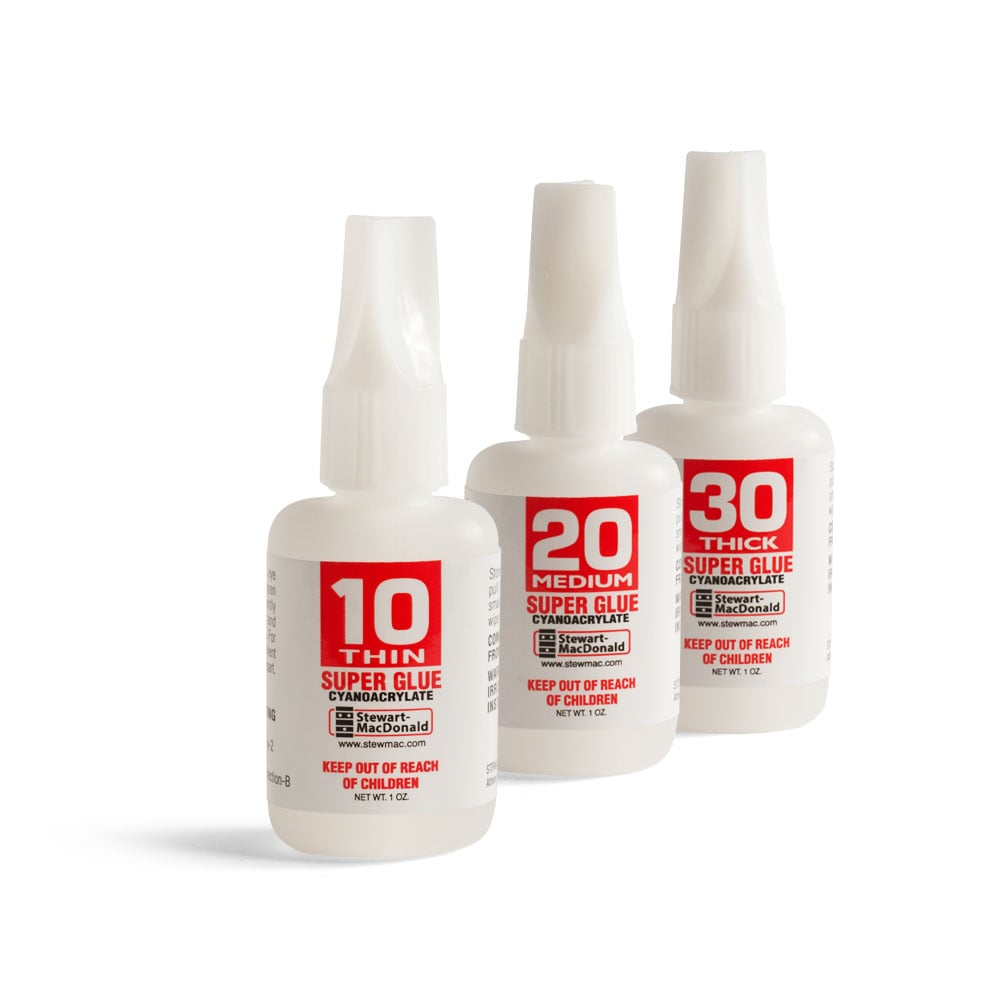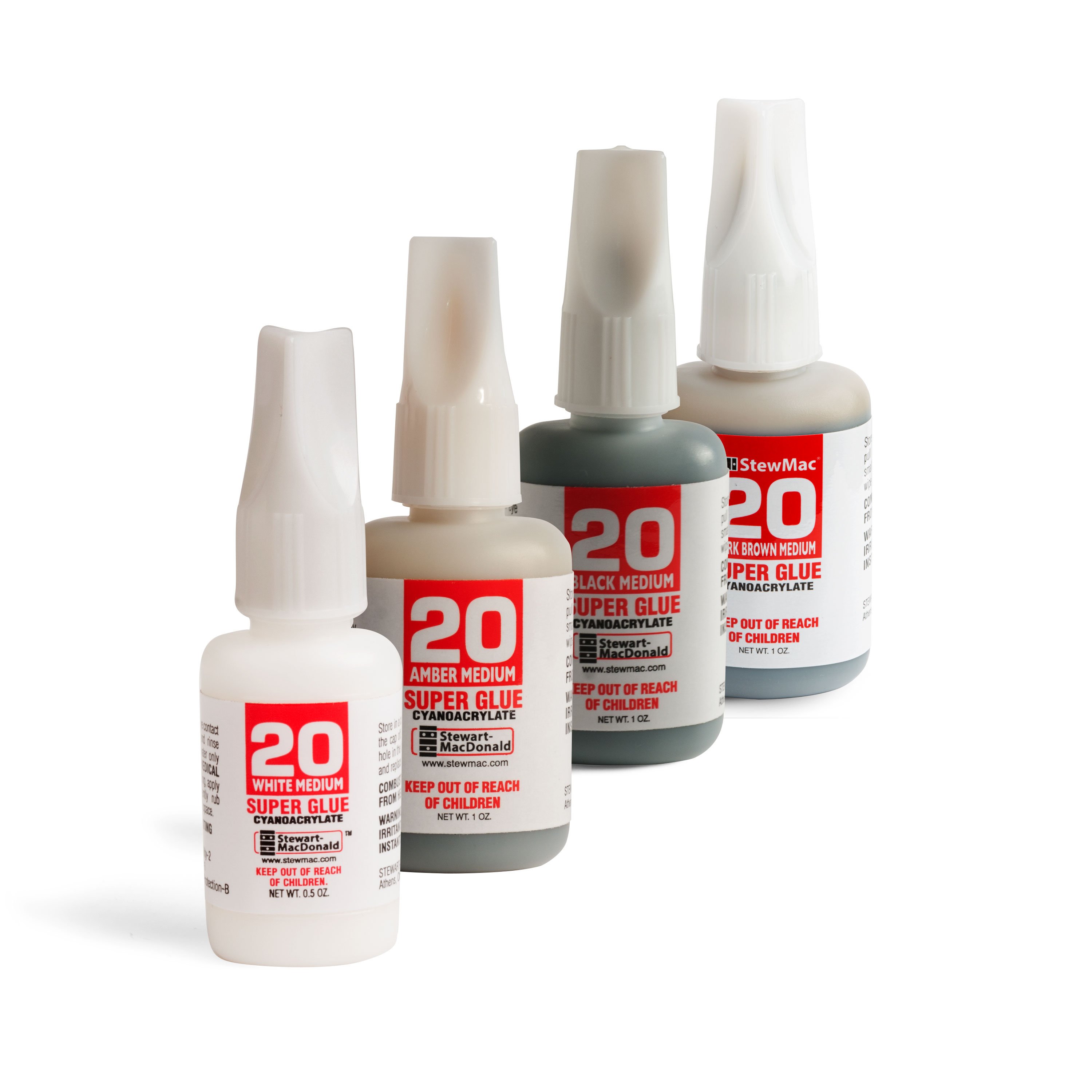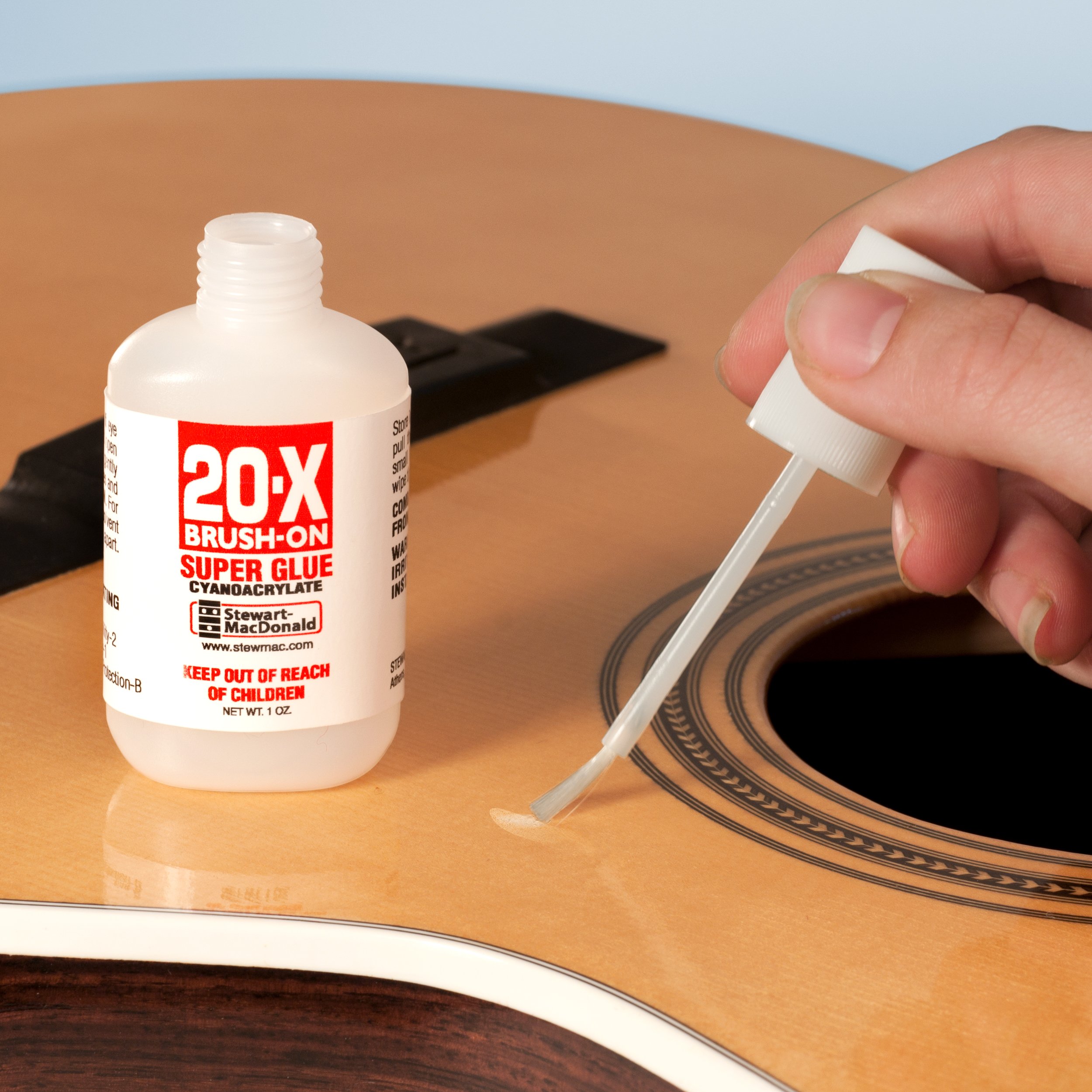Stewart-MacDonald Super Glues
An explanation of the characteristics and applications of different instant adhesives.
WARNING: These products are eye irritants and can bond skin instantly. Keep out of of the reach of children. Learn how to use super glue by testing on scrap before using it on the actual job. This will insure that the task goes smoothly and correctly. This is especially important with super glues, because there's little or no time for adjustment.
#10 Thin has a water-thin consistency and is used for bonding small, smooth surfaces (up to 1" square) which fit together well (no visible gaps). Align the parts and hold them firmly together by taping or clamping, then apply a small amount of #10 Thin to the joint or crack. The glue will be pulled deep into the joint by capillary action, and will cure in a few seconds. Porous wood is not a good candidate for this technique because it absorbs the glue before it can seep into the joint. For these woods, #20 Medium is a better choice. #20 Medium has the consistency of syrup and the ability to fill small gaps between parts which don't fit perfectly. #20 is the most commonly used super glue. Its consistency, cure time, and the option of clear, white, or black make it good for all types of repairs including finish touch-ups and binding repair. #20 cures at a slower rate than #10. Apply #20 in a spiral pattern to one part and then spread it evenly with a smooth, nonabsorbent disposable object (we recommend our angled plastic Drop-fill Toothpicks). Assemble and align the parts, holding them firmly together for 10-25 seconds (higher room temperatures make the glue cure faster and lower temperatures slow it down). Use #20 for finish drop-fills and for fast gluing of peghead veneers, jigs and fixtures. It's good for clean broken joints and for binding repairs. #20-X Brush-on Super Glue dries more slowly than standard #20. We don't recommend accelerating the area where you intend to apply brush-on glue, because the accelerator will harden the glue on the applicator brush. This glue is great for finish touch-ups, drop-fills, and many other applications because of its slow curing time and self-leveling properties. #30 Thick is a gap-filling glue and allows longer repositioning time. Apply it in a spiral pattern to one part, spread it evenly, then assemble and align the parts. Hold them firmly for 30-50 seconds. Accelerator reduces the curing time to 10-20 seconds (again, cure time is affected by room temperature). Accelerator cleans the bonding surfaces and makes the glue cure faster, which is helpful on resinous woods because they take longer to bond. The cleaner the bonding surface, the stronger the bond. Accelerator acts as a catalyst to start the glue's thermal reaction, and so is recommended for good curing at temperatures below 50° Fahrenheit. For joints with a surface area of 2 square inches or less, apply Accelerator to one surface and apply #20 Medium or #30 Thick glue to the other. Apply the glue in a spiral pattern (porous surfaces require more glue than nonporous). When clamped together, the accelerator and glue will react. Be prepared to align and clamp the parts instantly once they come into contact. The Accelerator can be sprayed up to 8 minutes in advance of bonding. It dries instantly with no visible residue, and a little goes a long way. Don't try to keep the area wet. The technique described above is not recommended with #10 Thin, because curing becomes too fast to allow time to assemble the parts. Very small joints (areas less than 1/2" square) can be accelerated by applying #10 Thin, clamping the parts tightly together, and applying Accelerator 4-6 inches away from the exposed joint. Note that the glue's penetration is lessened as curing speed gets faster. For frets, drop-fills and other finish touch-ups, use the brush-on accelerator or spray some aerosol accelerator into a small cup or container. You can then apply the accelerator with a plastic drop-fill toothpick, setting it next to, but not on, the wet glue and letting it run to the glue. Stewart-MacDonald Super Glues have a relatively long shelf life at room temperature: a bottle will be usable for up to a year, although the glue will thicken as the months go by. Once it is too thick for its original use, you can use it on other projects requiring a thicker glue. Ultraviolet rays (sunshine) will reduce the shelf life of cyanoacrylates. High temperatures can deteriorate the original bonding strength of the adhesive. Store in a cool dark location. Refrigeration at 40-50°F (5-10°C) is recommended for extended storage. Store partially-used bottles at room temperature: used bottles contain moist air from your workroom, which condenses and reduces shelf life. Always keep the bottles upright when not in use. Accelerator needs no special storage, but avoid high temperatures. NEVER store adhesives with an accelerator. Avoid moist or humid conditions. Replace cap tightly. Store in airtight conditions with a desiccant for best results. Glue spatters or is spilled onto a finished surface. Never use solvent or super glue remover to clean off a lacquered surface. There is no good solution. Prevention is the key: Mask off all areas surrounding your work, and never hold a bottle of glue over the instrument being worked on. Keep a bowl of water handy and a small wet rag. If glue gets on an instrument finish you can either let it harden and try to work it off, or wipe a small amount with water to stop its action and get it off the surface. You will still need to scrape, wet-sand, and polish out the surface, and it may never be perfect (depending, in part, on your experience with finish repairs). The curing time is excessive. Use less glue (about one drop per square inch of bonding area). When using #10 Thin, don't follow the same application techniques as for the gap-filling glues. Assemble the parts first, then apply. If the material is very porous, spray one part with Accelerator before assembly, and use one of the gap-filling glues. Accelerator can also be sprayed directly on the wet glue after bonding. Gaps are present that require additional filling. The wrong glue has been used for the job. Use #20 Medium or #30 Thick gap-filling glue for rough surfaces or glue joints that are not perfectly mated. Spraying with Accelerator before applying these glues speeds the curing and increases bonding strength. The gluing surfaces are contaminated with foreign materials. Oxidation, oils, dirt, water and acids can be in the material or deposited on it. Plywood, for example, is sometimes coated with a mold-release substance during manufacture; when not cleaned off, bonding can be difficult. Smog or acidic skin oil from handling can be factors. Woods containing excessive pitch may not bond well. Dampness reduces bond strength. Use Accelerator. It has a cleaning effect for a strong and immediate bond. The surfaces must be clean and dry; remove oil and dirt first, and remove oxidation with a light abrasive. The glue has been used cold, resulting in excessive curing time and reduced glue shelf life. Allow the bottle to reach room temperature before opening. Once a bottle has been opened, never return it to cold storage! Moisture drawn into the bottle from opening and usage will condense in cold storage and reduce shelf life. SKIN: Stewart-MacDonald Super Glue may instantly bond fingers and skin. Caution should be exercised and protective clothing and eyewear worn when using the adhesives. DO NOT try to pull bonded skin apart. Skin can be debonded with warm soapy water (and gentle manipulation of the bonded area to break the bond); a releasing agent, acetone, or other solvents. INGESTION: If accidentally swallowed, dilute by drinking large quantities of water. Immediately contact poison control center or get medical attention. EYES: Wear eye protection when using these glues. If Stewart-MacDonald Super Glue comes in contact with the eye, immediately hold eyelid open and rinse thoroughly but gently with only water for 15 minutes. Seek medical attention. NEVER use solvents or rub the eye. INHALATION: In a liquid state the adhesive may have a slightly irritating odor, so provide adequate ventilation when using it for a longer period of time. If inhaled, remove person to fresh air. KEEP OUT OF THE REACH OF CHILDREN. Contact Stewart-MacDonald's Customer Service at 1-800-848-2273 to receive the Materials Safety Data Sheets (MSDS). Stewart-MacDonald Super Glue will produce an exothermic reaction when it is polymerized (resinified). The exothermic reaction is particularly strong when large amounts of Stewart-MacDonald Super Glue monomer permeates a porous material, such as a woven cloth or urethane rubber, and quickly solidifies. If an accelerator such as caustic soda or amine is contained in such materials, the exothermic reaction will take place and can give off sufficient heat to cause burns. Disclaimer: "Seller makes no warranty, express or implied, concerning the product or merchantability or fitness thereof for any purpose except that the product shall conform to contracted specifications, and that the product does not infringe any valid United States patents. "The Buyer assumes the sole responsibility of determining the suitability of the product for the uses and application contemplated by Buyer and others. Furthermore, the Buyer assumes all risk and liabilities for results obtained by the use of the product, whether used singly or in combination with other material, except those relating solely to the use product not conforming to the contracted specifications, which non-conformity is not known to Buyer and is not discoverable by the Buyer, by testing or otherwise, prior to the use thereof by Buyer or others. Any suggestions or recommendations made by Seller concerning uses or applications of the product are believed to be reliable, but Seller makes no warranty or guarantee of results obtained since the conditions of the use and application by Buyer and others are beyond the Seller's control."Stewart-MacDonald Super Glues
Characteristics and usage
#10 Thin
#20 Medium
#20-X Brush-on
#30 Thick
Accelerator
A typical finish drop-fill:
Storage
Troubleshooting
Problem:
Solution:
Problem:
Solution:
Problem:
Solution:
Problem:
Solution:
Problem:
Solution:
Warnings and first aid





